Photo
Good info.
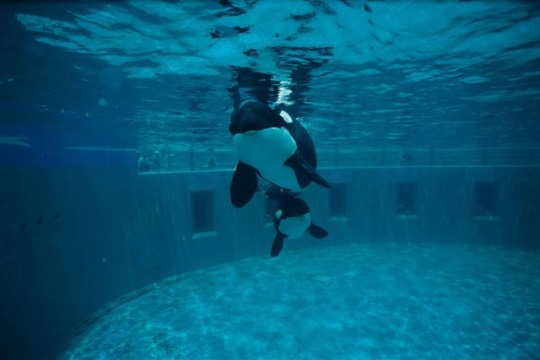
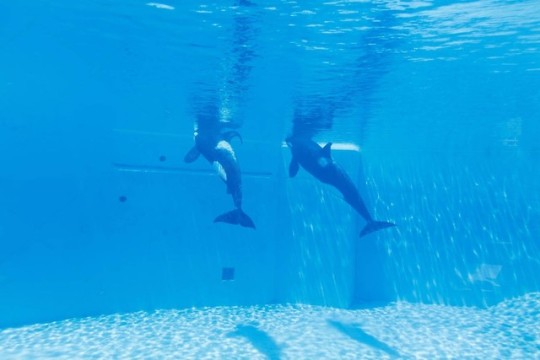
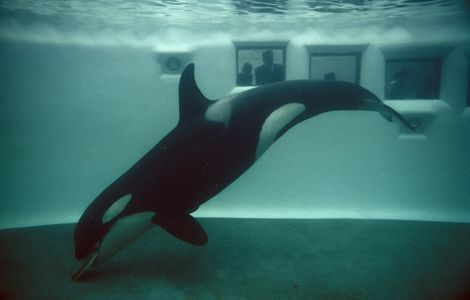
Why pool sizes are overrated
- but they do matter
I have made articles about sea pens and releasing whales - now for another of the possibly top 3 claims about zoological killer whales - the pools are way too small!
I will go through the killer whale facilities today and what has been before, from largest to smallest, behavior problems in other animals due to close confinement, and more. And I think I can prove to you that not one of the facilities holding killer whales today, even Lolita’s “whale bowl”, is in any way “too small” for the animals.
While researching this topic in order to get more meat on the bones of the argument than what I already knew, I found mostly anti-zoo propaganda and subjective blabbering about humanity’s view on animals.
I’m not even sure if I made up the term “cage madness”, or if it can be found elsewhere, but I will use it a lot.
I will thus write as I see fit, but try to back up my words as much as possible.
But don’t take it too seriously. This isn’t a scientific paper - it’s a tumblr post.
It is well-known to those with knowledge in the animal field - professional or not - that animals can and do display stereotypical behaviors if confined to too small areas for too long, especially if denied other stimulation.
Stereotypic behaviour is defined as a repetitive, invariant behaviour pattern with no obvious goal or function. Stereotypic behaviour is not seen in animals in the wild and is understood to be abnormal and is therefore a negative factor in conservation captive breeding.
To be clear, it is also never found in humans “in the wild”, or in our natural state, only when confined to the captivity and unnatural setting of modern society. I am being a bit tongue-in-cheek, but it’s also completely true, and worth thinking about. Moving on.
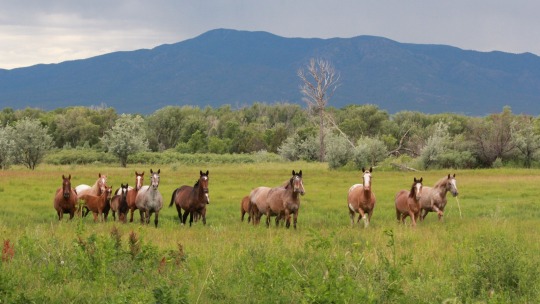
Horses might be the most widespread sufferer of “cage madness” and displaying of stereotypical behaviors (from now on, SBs), especially since they are a very common animal in “captivity”, and so commonly kept in deprivation confinement - it is downright standard practice in the entire modern world of horse-keeping.
Horses are naturally free-moving, social and more intelligent than you might think. Left to their own devices, they don’t spend all their day communicating in advanced ways, figuring out puzzles or running for miles on end for the fun of it, rather they just have their face stuck to the ground, eating, but they are moving, they are interacting, and they are being mentally stimulated by their environment.
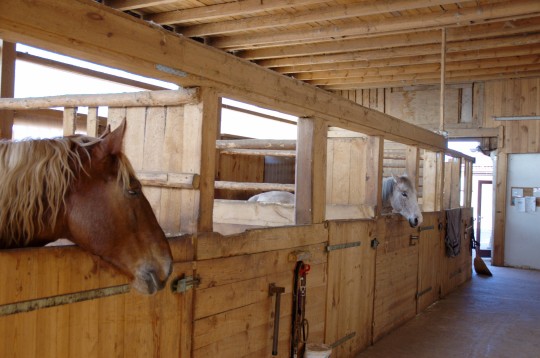
In a stall (I will completely ignore the worse alternative of tie stalls, where the horse is constantly tied up and can’t even turn around, but only speak of stalls where the horse has some freedom of movement), the horse is essentially living in a box, can only walk a few steps back and forth, and has only minimal contact with other horses. High-energy feed means less time spent grazing, and more time spent doing nothing.
Some more innovative and - I hesitate to say - empathetic horse owners give their horses toys and enrichment to entertain them in the stall, but most are never given anything like that, and it goes without saying that SBs in horses are almost exclusively found in stalled horses, never in free-range horses in large, naturalistic pastures and normal social groupings.
SBs in horses most often display themselves as
Weaving - moving weight from one front leg to the other, swinging their head along with the body movement. It is similar to head bobbing in elephants, and possibly rocking in humans.
Air sucking and cribbing - a horse will put their upper teeth on a surface, gape wide open and suck air in. There are contraptions (a type of collar) invented to prevent a horse from doing this, but it doesn‘t cure the cause, only the symptom.
In dogs, SBs include bouncing off the walls (in small kennels), and compulsive tail chasing. Watch this short video, and see how similar it is to the behavior of farmed foxes and minks.
In the video below, there are no animals being killed or skinned, but animals (minks and foxes) living in distress at Norwegian fur farms. I have timed it at 2:40, where you should see some SBs, as well as at 3:31, 4:25 and 4:59. These include spinning, jumping from wall to wall, and “running forward” by a single cage wall, staring straight ahead.
youtube
Many of the animals are injured by their cage mates, while some have actually self-inflicted this mutilation, including chewing off tails and even legs. That must surely be the most extreme and destructive form of cage madness, and it is never seen in free-ranging animals, or those living in large enclosures that satisfy their mental, emotional as well as physical needs.
Parrots are extremely intelligent, on a comparable level to dolphins, elephants and the great apes, and they are very common in captivity. It’s said upwards of 20 000 000 in the United States alone, but most of them are the smaller kinds, like budgies and lovebirds (and it also includes non-parrots, like finches). It is the large parrots like greys, cockatoos and macaws that are the most intelligent and sensitive.
In natural circumstances, they live in flocks or pairs, and spend most of their days flying, climbing, vocalizing, playing and interacting, and working for their food.

In captivity, more specifically in the typical pet situation, they are frequently kept alone, as the single bird in the house, in a cage a little wider than its wingspan, with food neatly peeled and prepared in a bowl.
Oftentimes, it is also wing-clipped, so even when it is outside of its cage, it’s mutilated and can’t move normally (this prevents enrichment from the enjoyment of flying as well as physical exercise, and it can also severely diminish “self-confidence” and feelings of security, especially when it’s done in young birds).
“Enrichment” consists of a metal bell or other indestructible toys and perches, for the more unlucky birds. Luckier birds have plenty of various toys and human companionship, but even those can suffer vast psychological problems due to confinement and deprivation.
Parrot SBs most often express themselves as feather plucking. It is quite widely known that a plucking bird is suffering in some way, but I just want to point out that it does not necessarily mean psychological suffering. There are many, many reasons behind feather plucking, including lack of showers (causing dry, itchy skin) and an incorrect diet (causing allergic reactions, also itchy skin).
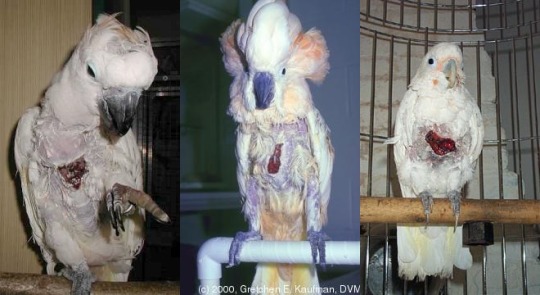
But among SBs in parrots suffering psychologically, feather plucking is the most common and obvious. The most extreme form of this expresses itself as the bird actually chewing into its own chest, causing deep wounds. This most extreme form can be likened to the self-mutilation of the above fur farm animals, and is almost exclusively found in white cockatoos.
Many also liken it to humans cutting their arms, an extreme behavior found in suffering humans in order to alleviate their psychological suffering. This behavior, of course, also does not exist in “free-ranging” humans outside of modern society.
Other parrot SBs include incessant screaming that go way beyond normal parrot vocalizations, chewing on bars, pacing, and more.
These are some major cases of “cage madness”, but it cannot be said that they are entirely due to the size of the animal’s enclosure. Deprivation is the key word. These animals are being deprived not only of the freedom of movement, but of mental stimulation and companionship.
Being physically restrained from moving normally is however, in itself, a deeply frustrating thing for an intelligent animal (for less intelligent animals too, but more so for mammals and birds, which are more capable of psychological suffering and frustration), besides just the physical health problems that can result from lack of movement.
Killer whale pools
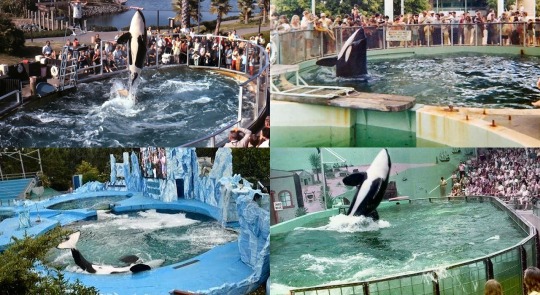
These four are among the smallest killer whale pools ever built.
The first is Shamu at SeaWorld San Diego, and she lived in that pool from 1965-1971 (when the current Dolphin Stadium was built), since 1967 with at least one other whale in the pool.
The second photo is of the current manatee pools at Miami Seaquarium. Hugo lived in those two, similarly sized pools for two years, before the current, infamous “whale bowl” (where Lolita lives) was built.
The third is a bit out of context, as there is a larger show pool to the left, out of view. This is one of the two (both visible) back pools at Mundo Marino, where Kshamenk currently lives since 1992, in company of a bottlenose dolphin. He does not live in that small pool as there is a larger show pool, out of view, but I included it to demonstrate what a too small pool would likely be if it were the permanent home.
The fourth is Mamuk at Sea-Arama Marine World, where he lived from his collection in 1968 until his death in 1974. There were two small gates in the back of the pool, that led to four minuscule back pools, and according to a 1972 article where the gates had to be enlarged in order to allow Mamuk to pass through, he did spend time in the back pools. In any case, the show pool seen here was the largest of the pool complex, and still possibly the smallest ever to house a killer whale permanently.
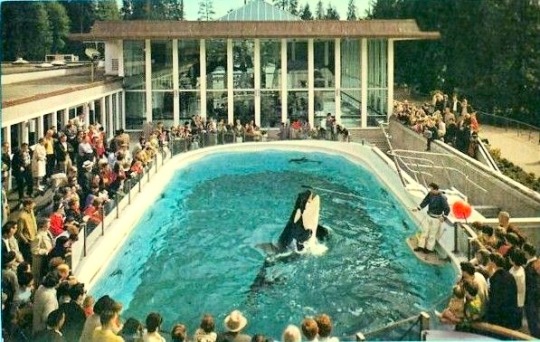
Skana lived very temporarily (ten days) at a Vancouver boat show, before moving on to Vancouver Aquarium. That pool is probably the one depicted in the top images, of the whale with a disk in very shallow water.

These images depict SeaWorld San Diego’s whale and dolphin stadium where the killer whales lived from 1971-1986, this specific image is from 1977 and it’s the only one I’ve seen where the pools are split.
The second is of young Ulises in the single pool at Barcelona Zoo, 1983-1994, which he shared with bottlenose dolphins. Acording to this 1992 article, it was 72 feet across and 16 feet deep (22 x 4.8 meters), which makes it less than 500 000 gallons.
The third is Corky 1 and Orky 2 in Marineland of the Pacific’s killer whale pool between 1967-1970, after which there was a pool swap where the killer whales were moved to the larger pool (below), and the dolphins and pilot whales got this smaller one.
The fourth shows Skana at Vancouver Aquarium. I’m not sure when they made a new pool for the killer whales, but it is unlikely to have happened before Skana’s death, so she likely lived in this pool from 1967 until her death in 1980.

Marineland of the Pacific’s four live-born calves all died within weeks or months due to a failure to nurse, and it’s often blamed on the size of the pool, here seen on the left with Corky breaching.
To the right is Kamogawa Sea World, a very similarly sized pool (plus back pool) which has had seven calves born, only one of which (the first) died in infancy. So I find that theory unlikely. Granted, a very small pool would prevent proper nursing, but these pools are not that small. All of Corky’s calves tried to nurse from her face, and the first calf was believed to have congenital brain damage.
Marineland’s pool looks bigger, but the measurements I got (no reliable sources), say Marineland’s pool was 80 feet across and 22 feet deep (24 x 6.7 meters) and held 640 000 gallons of water, while Kamogawa’s is 102 by 65 feet (D-shaped), 21 feet and holds about 920 000 gallons. Again, I’m not sure that’s accurate.

Lolita’s pool at Miami Seaquarium was, probably other than Marine World Africa USA’s pool complex, the largest killer whale pool in the world when it was unveiled in 1970. Today, it is the smallest, not counting medical pools that aren’t for permanent confinement.
It is 80 x 60 feet in surface area, not counting the extension behind the work island, and 20 feet deep. It is said to measure around 600 000 gallons.
The claim is that it is illegally small, but it only is by taking the work island into account (it has to be an unobstructed area). Without it, the pool is legal.
Miami Seaquarium has tried to build a new pool complex for her and the dolphins for years (1990s-2000s), but were stopped, largely because of activist pressure, who don’t want the animals to get larger pools, because they know taking the animals for themselves will be much harder if they animals are allowed better lives.
Now, as for my personal opinion: I wish Lolita had never been put in this pool in the first place. I wish it had been changed in the 1980s, or the 1990s, or even the 2000s.
If Miami Seaquarium suddenly got a permit today to build a new pool complex, 2½ million gallons like they planned, I would feel very cautious and think, just like moving Lolita anywhere else, that such a huge transition for such a geriatric, sensitive animal who hates even the slightest change to her schedule, would kill her. And I believe if they got a permit to build a new pool complex, maybe they would wait until she passed. Because it’s too late now.
I wish she had had a bigger habitat in the first place, and I wish they had got another killer whale to keep her company after Hugo’s death. Again, in the 1980s or 90s. Now that too, is too late.
Aside from my personal opinion, do I really think this pool is way too small, looking at the reality? No.
If it were, like I have written this article to prove to you, it would impact her physical and/or mental health in profound ways.
If you look at the record of killer whales in substandard facilities from back in the day (especially the 1970s, but also the 1980s and 60s), the whales died “like flies”. Some facilities had a death rate of 40% in the first year for new whales.
Killer whales are not so sensitive that they tend to die within days or weeks of being mistreated, but certainly months, or within a couple of years. Lolita has been in the same exact place, performing, doing well and showing all signs of being a well-adjusted, healthy whale, for nearly fifty years. That is not insignificant and should not be understated.
It’s easy for us to base it all on pool size and say “oh, they have small pools, so it must be a bad facility”, same for land animals as well. But actually, while larger enclosures are as a rule better than small, it does not mean an animal in the world’s largest enclosure is health or happy, and it does not mean an animal in a small cage is necessarily suffering.
You can find enormous, beautiful and modern feats of architecture and you’d think animal care matches the look of the place, but animals keep getting sick and dying. And you can find a place that looks like it’s barely been upgraded past 1960, and the animals are living long, healthy lives, because animal care has advanced, just not the facility’s size and appearance.
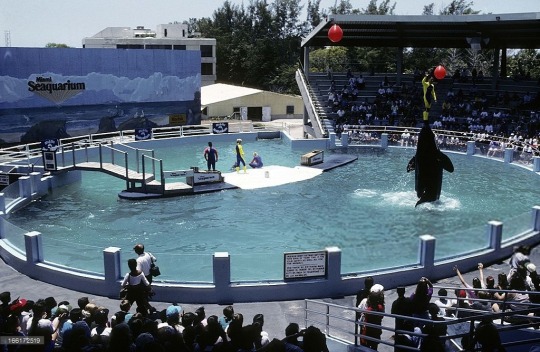
So what I’ve tried to establish is that whether an enclosure is large enough - not perfect, not ideal, but sufficient and just enough for an animal, should depend on simply two things:
That it is large enough to not negatively affect the animal’s mental health, where an enclosure that is too small frustrates the animal by not giving it enough space to move freely or engage in natural behaviors, and
That the enclosure is large enough to provide the animal with sufficient exercise to stay physically healthy
And regardless of the size of the enclosure, the animal must receive species-appropriate enrichment and company, to be kept happy and healthy.
So if an animal is mentally and physically healthy after living in that enclosure for some time (in Lolita’s case, almost five decades, it certainly qualifies as “some time”), it is clearly sufficient.
Not because I look at it subjectively and think it looks nice (because I don’t), but because of how the animal living there for nearly half a century is doing.
27 notes
·
View notes
Text
Hello orcinus-ocean! I have posted a response to you and the girlwithorcatattoo on my first Tumblr blog post. Have a look on the research I have done regarding the MSQ and Lolita. https://atomicowlking.tumblr.com/post/616335878206488576/response-to-girlwiththeorcatattoo
instagram
I wonder a lot of things about this photo, but my heart aches for Hugo and Lolita. They deserved more than that tiny bowl Miami Seaquarium thinks is suitable.
12 notes
·
View notes
Text
I’m Pro-SeaWorld!
Is there literally no ProSeaWorld side of Tumblr????
If you are pro SeaWorld, like or reblog this post.
250 notes
·
View notes
Text
Response to girlwiththeorcatattoo and orcinus-ocean
I saw a couple posts by orcinus-ocean and girlwiththeorcatattoo about the Miami Seaquarium’s controversial care of Lolita, their star Orca. Girlwiththeorcatattoo posted some information from the Miami Herald about an attorney by the name of Stephen Helfman and his comments that the Seaquarium was faking its past legal battles to expand Lolita’s habitat as a mask to absolve itself of criticism. Helfman’s statement was backed up that the MSQ was completely available to do whatever it wants without the city of Miami’s approval and that they were given the chance in sept of 2001 but the 9/11 terrorist attacks squashed it. Helfman further stated that it has been 19 years since that and the MSQ has not returned to its rebuilding plan. He states that the MSQ is hiding behind its legal battles in the 90s to paint a false positive light about it. I don’t think so, because I did some research and it turns out the the MSQ did in-fact tried to expand Lolita’s habitat in 2003 and still had legal obstacles in the way.
https://www.bizjournals.com/southflorida/stories/2003/09/08/story8.html
“Expansion of the whale stadium, home to Lolita, one of the oldest killer whales in captivity, is under way, Hertz said. He expects to start working on the 2.5 million-gallon stadium tank - about five times bigger than the current one - in a couple of months.”
Of course that was a decade ago and it was acknowledged in the Miami Herald post that Girlwiththeorcatattoo linked that the MSQ’s plans to expand Lolita’s tank was ultimately cancelled and the marine park gave up on updating the orca’s exhibit. But, contrary to what Helfman stated, the MSQ did in-fact tried and tried again to expand Lolita’s tank two years after it was, according to him, ruined by the 9/11 attacks. I think maybe the MSQ tried a few times again in the 2000′s but they did finally gave up. But it doesn’t matter anymore to be honest, because Lolita has been alive and healthy for 50 years now, she has good medical care, fresh food, toys, companionship with the dolphins and her trainers, and the performance shows are a good form of enrichment and exercise for her. If she was suffering at that tank, she would’ve died a long time ago due to stress and melancholy. Ceteceans aren’t resilient to mental deterioration as humans are. But she is one of the oldest orcas in captivity and has so far no history of illness, despite her small tank. So the MSQ did something right to keep her alive for so long and I think Lolita doesn’t even care about how small her exhibit, I think she is content and wouldn’t even like to be placed in a bigger pool as it is described that she is resistant to change in any form and that she can feel very stressed out from any change of her daily life, show schedules, or changes in her tank. The fact that there is debate about keeping Lolita at the MSQ is proof that the aquarium does a good job as she is living, and if she died decades ago this heated debate would not happen.
1 note
·
View note